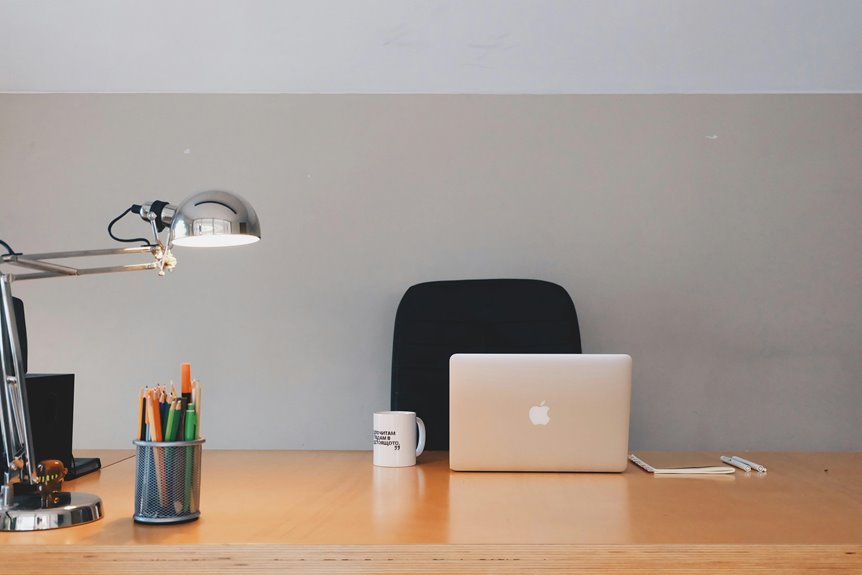When deciding whether to place your desk in the middle of the room or against the wall, consider your workflow. A central desk encourages collaboration and creativity but can lead to distractions. Conversely, a wall-mounted desk maximizes space and minimizes clutter but may feel isolating. Think about natural light, flow, and your personal preferences. Finding the right balance is key to an effective workspace, and there’s more to explore about personalizing and organizing your setup.
Table of Contents
Key Takeaways
- Placing your desk in the middle fosters collaboration and a dynamic atmosphere, encouraging creativity and idea flow.
- A wall-mounted desk maximizes floor space and reduces distractions, allowing for greater focus on tasks.
- Central desk placement offers a 360-degree view but may expose you to distractions and limit personal boundaries.
- Wall setups provide organization options but can lead to a feeling of confinement and isolation.
- Consider factors like natural light, room flow, and personal preferences to determine the best desk placement for your needs.
Benefits of Placing Your Desk in the Middle of the Room
Placing your desk in the middle of the room can transform your workspace into a dynamic hub of creativity and productivity. This arrangement encourages open movement, allowing ideas to flow more freely.
You’ll find it’s easier to engage with others, fostering collaboration and communication. A central desk placement also creates a sense of balance, as it draws attention and promotes a welcoming atmosphere.
With a 360-degree view, you can easily access your materials and enjoy natural light from all angles. Plus, this setup can enhance your focus by minimizing distractions, as you’re less likely to get lost in a corner.
Embrace this layout to boost your motivation and make your workspace feel more inviting and vibrant.
Drawbacks of a Central Desk Placement
While a central desk placement can enhance collaboration, it also presents several drawbacks that may hinder productivity.
First, you might find yourself easily distracted by movement and conversations happening around you. This constant stimulation can make it tough to concentrate on your work.
Second, a central desk often limits your options for organizing your space, leading to clutter and disarray. You may struggle to establish personal boundaries, making it hard to create a focused work environment.
Additionally, if you require privacy for sensitive tasks or phone calls, a central location can feel exposing.
Finally, if you have limited space, a central desk might obstruct pathways, creating potential hazards and reducing overall functionality in your workspace.
Advantages of Positioning Your Desk Against the Wall
Positioning your desk against the wall can really optimize your floor space, making your room feel more open.
It also helps reduce distractions, allowing you to focus better on your tasks.
Plus, you’ll access more options for wall storage, keeping your workspace organized and efficient.
Maximizes Floor Space
One of the biggest advantages of placing your desk against the wall is that it maximizes your floor space. By positioning your desk in this way, you create a more open area in the center of the room, allowing for easier movement.
This setup can make your workspace feel less cramped and more organized, giving you the freedom to add other furniture or decorative elements without feeling overcrowded. You can also utilize wall space for shelves or storage, making everything more accessible.
Plus, with more floor space, you can easily clean and maintain the area, which contributes to a more pleasant working environment. Ultimately, you’ll find it easier to focus and be productive in a well-arranged space.
Reduces Distractions Effectively
By placing your desk against the wall, you effectively create a focused workspace that minimizes distractions. This position limits the number of visual stimuli vying for your attention. You’re less likely to be sidetracked by movement or clutter in your peripheral vision.
Here’s a quick breakdown:
| Advantages | Benefits | Impact on Productivity |
|---|---|---|
| Reduced Visual Clutter | Less distraction | Increased focus |
| Enhanced Privacy | Fewer interruptions | Better concentration |
| Clear Boundaries | Defined workspace | Improved time management |
With fewer distractions, you can dive deep into your tasks and maintain a steady workflow, allowing for more efficient and productive working hours.
Enhances Wall Storage Options
Creating a focused workspace not only reduces distractions but also opens up opportunities for enhanced wall storage options.
When you position your desk against the wall, you can optimize the vertical space around you, making it easier to access essential items. Wall shelves, pegboards, or hooks can hold your supplies, freeing up your desk for more important tasks.
This setup keeps your workspace organized and visually appealing, allowing you to display items that inspire creativity. You can also install cabinets or floating shelves to store books or files, ensuring everything’s within reach yet neatly tucked away.
Disadvantages of a Wall-Mounted Desk Setup
While a wall-mounted desk can save space, it also limits your spatial awareness, making you feel boxed in.
You might find it harder to collaborate with others, as the setup isolates you from your team.
Plus, without proper organization, clutter can quickly accumulate and create a chaotic workspace.
Limited Spatial Awareness
How does a wall-mounted desk affect your spatial awareness? When you position your desk against the wall, you may feel more confined in your workspace.
This setup can create a sense of isolation, limiting your ability to see and interact with the room around you. You’ll likely miss out on the natural flow of movement, which can make your environment feel smaller and more cramped.
With your back to the room, you may also find it harder to stay engaged with your surroundings, leading to decreased focus and creativity. This limited perspective can stifle your productivity, as you might feel boxed in rather than inspired by the space.
Restricted Collaboration Opportunities
Although a wall-mounted desk can save space, it considerably restricts collaboration opportunities.
When you place your desk against a wall, it limits your ability to engage with others in a spontaneous way. You won’t easily turn around to discuss ideas or brainstorm with coworkers. This setup may also isolate you, making it harder to build relationships and foster teamwork.
If you’re in a shared office or co-working space, you might miss out on valuable interactions that could spark creativity and innovation. The lack of open space can stifle communication, leaving you feeling disconnected.
To encourage collaboration, consider positioning your desk in a more accessible area, allowing you to interact with colleagues easily and create a more dynamic work environment.
Potential for Clutter Accumulation
When you opt for a wall-mounted desk, you might unintentionally create an environment ripe for clutter accumulation.
With limited surface area, it’s tempting to stack papers, office supplies, and personal items on your desk instead of organizing them properly. This can quickly lead to a chaotic workspace that hinders productivity and focus.
Additionally, being against the wall can make it easier to ignore clutter, as it’s out of your direct line of sight. You might find yourself shoving items to the side rather than addressing them.
To combat this, you’ll need to establish a consistent decluttering routine and utilize storage solutions effectively.
Otherwise, your wall-mounted desk could become a clutter magnet, negatively impacting your work environment.
Factors to Consider When Choosing Your Desk Placement
Choosing the right desk placement involves several important factors that can greatly impact your productivity and comfort.
First, consider the natural light in your space. Positioning your desk near a window can boost your mood and energy, but too much glare on your screen can be distracting.
Next, think about the flow of your room. You want easy access to your desk while ensuring it doesn’t obstruct pathways.
The proximity to power outlets is also essential for your devices.
Finally, consider your personal preferences—some people thrive in an open area, while others feel more secure against a wall.
Finding a balance between these factors will help you create an effective workspace tailored to your needs.
Personalizing Your Workspace for Maximum Productivity
Once you’ve found the ideal desk placement, personalizing your workspace can further enhance your productivity. Start by adding items that inspire you, like photos or artwork. Incorporate plants to bring a touch of nature indoors; they can boost your mood and air quality.
Ascertain your workspace is organized—use trays or drawer dividers to keep essentials within reach without cluttering your desk. Consider your lighting; a good desk lamp can reduce eye strain and create a cozy atmosphere.
Don’t forget ergonomic accessories like a comfortable chair and keyboard wrist support to promote good posture. Finally, choose colors that energize or calm you, depending on your work style. Tailoring your space to your preferences will help you stay focused and motivated.
Frequently Asked Questions
How Does Desk Placement Affect My Posture and Ergonomics?
Desk placement directly impacts your posture and ergonomics. When you position your desk correctly, it encourages proper alignment, reducing strain on your back and neck. You’ll feel more comfortable and productive throughout your workday.
What Are Some Creative Desk Arrangements for Small Spaces?
Get creative with corner desks, wall-mounted options, or foldable tables. Use vertical storage to maximize space, and consider a rolling cart for flexibility. Rearranging furniture often sparks new ideas for a functional workspace.
Can Desk Placement Influence My Mood or Creativity?
Absolutely, desk placement can greatly influence your mood and creativity. When you choose an inspiring view or open space, it boosts motivation. Experiment with different arrangements to see what sparks your energy and focus.
How Do I Decide on Desk Height Relative to Placement?
To decide on desk height, consider your chair’s height and your comfort. If your arms rest naturally while typing, you’re good. Test different heights to find what suits your workflow and posture best.
What Accessories Enhance Productivity Based on Desk Location?
To enhance productivity, consider using a monitor stand for better screen visibility, cable organizers to reduce clutter, and a desk lamp for focused lighting. These accessories optimize your workspace, no matter where your desk is located.



